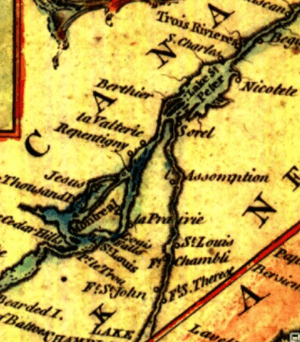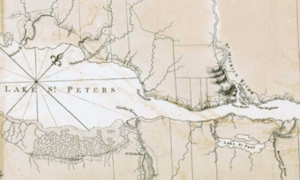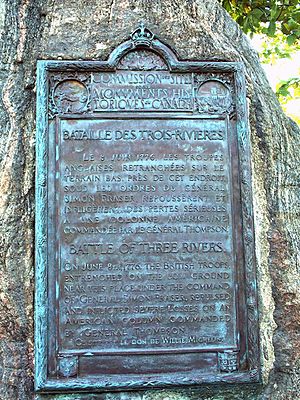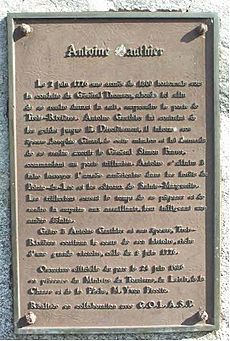Battle of Trois-Rivières facts for kids
Quick facts for kids Battle of Trois-Rivières |
|||||||
|---|---|---|---|---|---|---|---|
| Part of the American Revolutionary War | |||||||
 Detail of a 1759 map showing Trois-Rivières and Sorel. |
|||||||
|
|||||||
| Belligerents | |||||||
| Commanders and leaders | |||||||
| Strength | |||||||
| 2,000 | 1,000+ | ||||||
| Casualties and losses | |||||||
| 30–50 killed c. 30 wounded 236 captured |
8 dead, |
||||||
| Official name: Battle of Trois-Rivières National Historic Site of Canada | |||||||
| Designated: | 1920 | ||||||
The Battle of Trois-Rivières was a key fight during the American Revolutionary War on June 8, 1776. It happened in Trois-Rivières, a town in Quebec. In this battle, a British army led by Governor Guy Carleton defeated American forces. The Americans, part of the Continental Army under General William Thompson, were trying to stop the British from moving up the Saint Lawrence River.
This battle was part of the American invasion of Quebec. This invasion started in September 1775. The American colonists wanted to take Quebec away from British rule. Local people saw the American troops crossing the Saint Lawrence River. They quickly told the British soldiers in Trois-Rivières. A local farmer then led the Americans into a big swamp. This gave the British time to bring more soldiers to the village. They set up their positions behind the American army.
After a short fight, the Americans had to retreat in a messy way. Some escape routes were blocked. The British captured many American soldiers, including General Thompson and many of his officers. This battle was the last one fought in Quebec during the war. After this loss, the remaining American forces, led by John Sullivan, pulled back. They went first to Fort Saint-Jean and then to Fort Ticonderoga.
Contents
Why the Battle Happened: The Background
The Continental Army had invaded Quebec in September 1775. But they faced a big problem with a terrible attack on Quebec City on New Year's Eve in 1775. After that defeat, Benedict Arnold and the rest of the army kept Quebec City under siege until May 1776.
On May 6, three Royal Navy ships arrived in Quebec Harbour. Soldiers from these ships quickly went into the city. Soon after, General Guy Carleton gathered them. He marched them out to the American camp that was surrounding the city. General John Thomas, who was in charge of the American forces, was already planning to retreat. But the arrival of the British ships caused his troops to panic. He led a messy retreat that ended up in Sorel around May 18.
British Forces Gather at Trois-Rivières
Throughout May and early June, more ships arrived in Quebec. These ships carried soldiers and war supplies. By June 2, General Carleton had many more troops. These included the 9th, 20th, 29th, 53rd, and 60th regiments of foot. General John Burgoyne also joined his command. Hessian troops from Brunswick, led by Baron Riedesel, also arrived.
After the Americans fled in early May, Carleton did not make any big attacks. But on May 22, he sent ships with parts of the 47th and 29th Foot regiments to Trois-Rivières. These were under the command of Allan Maclean. Brigadier General Simon Fraser led more soldiers to Trois-Rivières on June 2. By June 7, nearly 1,000 soldiers were on the ground at Trois-Rivières. Also, 25 ships with more troops and supplies were anchored in the river nearby.
American Plans and Movements
General Thomas's retreat happened because only three ships arrived with a few hundred British troops. He did not know how large the British army truly was. On May 21, a meeting was held in Sorel. Representatives from the Second Continental Congress were there. They decided to make a stand at Deschambault, which is between Trois-Rivières and Quebec. This decision was based on unclear reports and rumors about British troop numbers. The non-military Congressional representatives mostly made this choice.
General Thomas caught smallpox on May 21 and died on June 2. Brigadier General William Thompson briefly took command. He then gave command to General John Sullivan, who arrived on June 5 at Sorel with more soldiers from Fort Ticonderoga.
On June 5, just hours before Sullivan arrived, Thompson sent 600 soldiers. These troops, led by Colonel Arthur St. Clair, headed towards Trois-Rivières. Their goal was to surprise and defeat the small British force they thought was there. When Sullivan arrived, he immediately sent Thompson with 1,600 more men to follow. These forces met St. Clair at Nicolet. The next day, they built defenses there to stop troop movements on the river. On the night of June 7, Thompson, St. Clair, and about 2,000 men crossed the river. They landed at Pointe du Lac, a few miles above Trois-Rivières.
The Battle Unfolds
A local militia captain saw the Americans crossing the river. He quickly went to the British camp at Trois-Rivières and told General Fraser. Thompson left 250 men to guard the landing spot. He then led the rest of his troops towards Trois-Rivières. He did not know the local area well. So, he asked Antoine Gautier, a local farmer, to guide his men. Gautier seemed to intentionally lead the American army into a deep, muddy swamp. It took them hours to get out.
Meanwhile, the British knew the Americans were there. They quickly brought soldiers from their ships. They formed battle lines on the road outside the village. British ships also went up to Pointe du Lac. They forced the American guards there to flee across the river, taking most of their boats.
Some Americans, led by Thompson, finally got out of the swamp. But they faced HMS Martin, a British ship. The ship fired grapeshot, forcing them back into the swamp. A group of men under Colonel Anthony Wayne had a little more luck. They came out of the swamp only to face General Fraser's soldiers. A short fight happened. But the Americans were clearly outnumbered by Fraser's forces. They broke and ran, leaving their weapons and supplies behind.
Parts of the American force retreated to the edge of the woods for cover. They tried to fight some British troops. But fire from those troops kept them off the road. Fire from some ships in the river kept them from the shore. St. Clair and some men made it back to the landing site. But they found it was now held by British troops. These men only escaped capture by going back into the swampy woods and running further upriver. Wayne eventually managed to form a rear guard of about 800 men. They tried to attack the British position but were pushed back into the woods. Wayne then led a slow retreat. Companies of men slipped away, using the woods to hide how many they truly were.
General Carleton arrived in Trois-Rivières late in the battle. A group of British soldiers, led by Major Grant, had taken control of a bridge over the Rivière-du-Loup. This bridge was very important for the Americans retreating along the north side of the Saint Lawrence. Carleton ordered Grant to pull back. This allowed most of the Americans to escape. He might have done this because he did not want to deal with many prisoners. Or perhaps he wanted to make the Americans feel even more defeated.
However, many Americans did not make it that far and were captured. This included General Thompson and seventeen of his officers. The British finished gathering the scattered American soldiers by June 13. In total, 236 Americans were captured. About 30 to 50 Americans were killed in the battle.
What Happened Next
Scattered groups of the American army traveled overland on the northern shore to Berthier. From there, they crossed over to Sorel. Some did not return until June 11. Sullivan, who had 2,500 healthy troops, first wanted to make a stand at Sorel. But smallpox, soldiers leaving, and news that the British fleet was sailing upriver convinced him it was time to retreat.
By June 17, the Continental Army had left Quebec. But before they left, they tried to burn Montreal. They also destroyed Fort Saint-Jean and any boats that could be used on Lake Champlain.
Carleton ordered most of the British army to sail upriver towards Sorel on June 9. But they did not actually leave until he joined them on June 13. A group of 1,200 men under Fraser marched up the northern shore towards Berthier and Montreal. The British fleet arrived at Sorel late on the 14th. The Americans had left there just that morning. Parts of the British army entered Montreal on June 17. They also arrived at Fort Saint-Jean in time to see the last Americans, including Benedict Arnold, leave its burning ruins.
General Carleton treated the captured Americans very kindly. Even though their prison conditions were not always good, he gave them clothes. Eventually, all but the officers were sent to New York and set free.
Remembering the Battle
A place near the Le Jeune bridge was named a National Historic Site of Canada in 1920. This was done to remember the battle.
There are three plaques in the city of Trois-Rivières that honor different parts of the battle.
- A plaque honoring the British soldiers was placed at the National Historic Site.
- A plaque honoring the American soldiers who died was placed in Parc Champlain by the Daughters of the American Revolution in August 1985.
- The third plaque honors Antoine Gautier for misleading the American troops.
During the American retreat from Quebec and in this battle, wounded soldiers were treated at the Ursuline convent in Trois-Rivières. The American Congress never paid for these services. The convent still has the bill. By the early 21st century, the original bill of about £26 was estimated to be worth between ten and twenty million Canadian dollars if compound interest was added. On July 4, 2009, during celebrations for the town's 375th anniversary, American Consul-General David Fetter symbolically paid the debt to the Ursulines with C$130.





